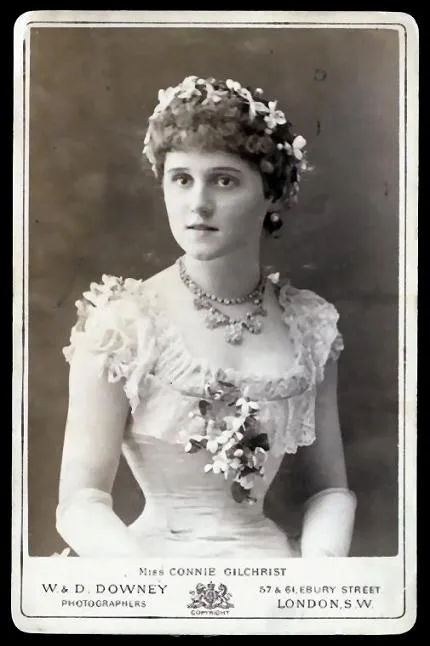Connie Gilchrist Was the Shirley Temple of Victorian London
The child star captivated audiences and artists alike, served as muse for Lewis Carroll, James McNeill Whistler
:focal(467x382:468x383)/https://tf-cmsv2-smithsonianmag-media.s3.amazonaws.com/filer/52/82/5282876b-0f9c-4288-b897-e20b74b84f54/col_gag_1039.jpg)
Long before Shirley Temple and her curls paved the way for child stars to storm the silver screen, a young girl named Connie Gilchrist held all of Victorian London in thrall, entrancing artistic luminaries from James McNeill Whistler to Lewis Carroll, William Powell Frith and Frederic Leighton. But today, Gilchrist’s name is largely forgotten—a fact that researchers from the City of London’s Guildhall Art Gallery hope to rectify in a new exhibition exploring Victorian attitudes toward childhood.
The show, called Seen and Heard: Victorian Children in the Frame, details 50 Victorian-era paintings, including a canvas by Frederic Leighton that depicts a cherubic young model, resplendent in a gown of sky blue, playing a stringed instrument. As it turns out, the girl in the “The Music Lesson,” as the 1877 painting is titled, is none other than Connie Gilchrist.
As Vanessa Thorpe reports for the Observer, Gilchrist’s life tells us much about stardom in Victorian Britain. Her story plays out like a quintessential rags-to-riches legend: Born in the slums behind King’s Cross station in 1865, she was pushed into show business by her mother. Beginning at age four, she modeled for the era’s top artists, appearing in works such as Leighton’s “Young Fatima" and “The Daphnephoria," as well as Whistler’s “Harmony in Yellow and Gold: The Gold Girl” and “The Blue Girl.”
In addition to sitting for portraits, Gilchrist performed in juvenile pantomines and music halls. According to A. Varty’s Children and Theatre in Victorian Britain, her earliest stage appearance took place in 1873, when she portrayed the Prince of Mushrooms in Jack in the Box at Drury Lane Theatre. Three years later, her run as Harlequin in the Adelphi children’s pantomine of Little Goody Two-Shoes triggered a meteoric rise to prominence.
“Her features somehow caught the Victorian imagination,” curator Katty Pearce tells Thorpe. “She was painted several times, even before her fame at the Drury Lane theatre, which took off around the time of the painting and was really like her Britain’s Got Talent moment.”
/https://tf-cmsv2-smithsonianmag-media.s3.amazonaws.com/filer/73/e0/73e0a837-9d28-4a62-92e8-f0aebe54b556/main-image.jpeg)
At age 12, Gilchrist launched a novelty jump rope act at London’s Gaiety Theatre, soon earning the title of “the original Gaiety Girl.” Around the same time, she posed for Whistler’s “Harmony in Yellow and Gold,” a playful rendition of her skipping-rope routine. The painting, now housed at the Metropolitan Museum of Art in New York, is one of the artist’s few attempts at depicting a life-sized figure in motion and was lauded by critic Charles E. Pascoe as “a common-sense and lifelike portrait with neither hazy light nor incomprehensible misty effects.” Gilchrist herself received much adulation for the act, with the New York Times reporting that “her ingenuousness [captured] all hearts.”
One of the theatregoers who caught Gilchrist’s star-making turn was Charles Dodgson, better known by the pen name Lewis Carroll. The charismatic child star instantly caught his attention; after the performance, Carroll wrote a diary entry describing her as “one of the most beautiful children ... that I have ever seen.” After spending more time with Gilchrist, he doubled this praise, noting her “refined and modest manner, with just a touch of shyness.” For whatever reason, Carroll’s admiration appeared to have paled by 1878, when he declared that Gilchrist “is losing her beauty and can’t act.” Still, he admitted, “She did the old skipping rope dance superbly.”
Gilchrist didn’t stop after achieving childhood stardom—as a young woman in the 1880s, she starred in a steady stream of plays, including Little Robin Hood, Blue Beard and Bubbles, a so-called “comedietta” written specifically for her. Buoyed by the success of an American tour and the support of two wealthy benefactors, Lord Lonsdale and the Duke of Beaufort, she left the stage for good in 1886.
“Connie had been pushed into celebrity by her mother, it seems, in the hope she would be able to pull the family out of poverty—which she eventually did,” Pearce tells the Observer. “But although she appeared in hundreds of stage shows, becoming a star turn, those who met her in artists’ studios remembered her as quite a sad little girl.”

As Pearce explains to Smithsonian.com, Gilchrist's career found her inhabitating a different sphere than most children of the Victorian era, who were consigned to factory work, sweeping the streets and similarly menial tasks. Still, the young star was exploited much like her peers, in large part due to the lack of child labor laws at the time.
"Although she reached a position of privilege," Pearce concludes, "she was pressured into her situation from a young age and treated rather badly by her mother."
In 1892, then 27-year-old Gilchrist married Edmond Walter FitzMaurice, the seventh Earl of Orkney. The couple had one daughter, Lady Mary Gosling, and spent most of their time in the countryside rather than mingling in London with other members of the peerage. At the time of her death in 1946, the one-time “Gaiety Girl” was better-known as the Countess of Orkney, and her indelible contributions to the Victorian arts scene were little-known.
Luckily, Leighton’s 1877 “Music Lesson,” which depicts Gilchrist learning how to play a Turkish lute, is undergoing a new renaissance as one of the highlights of Guildhall's Seen and Heard. And as any visitor who stops to examine the lush canvas can attest, the scene leaves little question as to why Gilchrist wielded such a magnetic hold on audiences and artists alike.
/https://tf-cmsv2-smithsonianmag-media.s3.amazonaws.com/accounts/headshot/mellon.png)
/https://tf-cmsv2-smithsonianmag-media.s3.amazonaws.com/accounts/headshot/mellon.png)